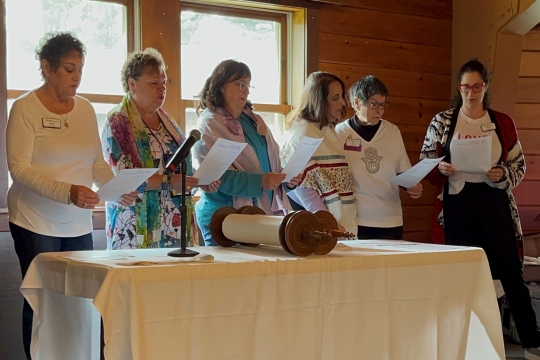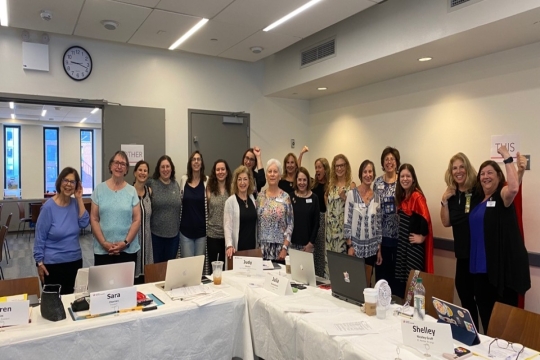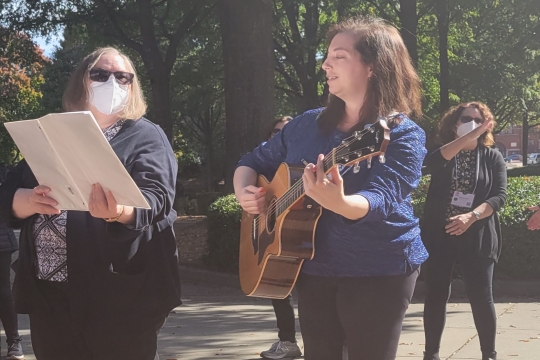by Pamela Feldman-Hill
The Torah portion Ki Tisa (Exodus 30:11 – 34:35) is chock-full of big ideas and startling imagery, so how to choose a focus? Do I discuss the census and how every person must be “counted?” Shall I connect the purification of the Israelites’ meeting space to the sacred potential of our gatherings? We are introduced to Bezalel, the great artisan, and his role in adding beauty and wisdom to our traditions (a personal favorite!), along with a reiteration of the centrality of Shabbat to our covenant with God. And then comes the dramatic story of the golden calf, including the breaking of the tablets by Moses, his plea to God to forgive the Jewish people, and Moses’s subsequent meeting with God and receipt of our Covenant, delivered to the Israelites with radiance.
One of my first thoughts when reading through the portion was, “Where was Aaron?” As the appointed leader of the people in Moses’s absence, he does not seem to do much “leading,” as his flock commits the ultimate sin against the God that just redeemed them from Egypt. It appears that Aaron has thrown the Israelites under the bus, as he allows his flock to fail miserably. And yet, our sages continue to hold Aaron up as a great and exemplary leader; so I wondered…how so?
Aaron is described as a compromiser and peacemaker. When the Israelites approach him demanding the creation of an idol, Aaron does not try to sway them from their path, but instead attempts to slow them down in hopes that Moses will return before the task is completed. He does not abandon the people simply because he knows that they are making a mistake, or because he disagrees with them. Aaron understands that in their fear, the Israelites revert to their old ways in Egypt and to what is familiar and comfortable, and he allows them to move forward with their plans, knowing that they will fail. It is, in part, their failure which allows the Israelites to be emotionally ready to hear and accept the words that Moses later brings to them from God.
As leaders, it is essential that we understand where our “flock” is coming from. Change is frightening, and it is human nature to revert to what is known and comfortable, rather than to embrace the scary, and inevitable, business of change. How many times have we all heard in protest “…but we’ve always done it this way!”
Our changing times are causing great shifts in the Reform Movement and in American Jewish life, and we must try to recommend new paths. However, we also have to listen closely to our own Israelites, as Aaron does, for ultimately our rank and file must be ready and open to embrace change. Even the greatest leader cannot impose change and understanding if their flock is not ready to listen. We can do our best to lead our sisters in directions that we think are appropriate, but we can not force them to follow.
Much has been written about the differing leadership styles of Moses and Aaron. Moses is the impassioned, loving, and fearless visionary, and I admit to most often embracing this leadership style, and to shouting from the proverbial mountain everything that I think our sisterhoods “ought” or “need” to do. However, I acknowledge that it is Aaron’s leadership style which is often more successful. Aaron is more sensitive to the fears and needs of his flock, and allows the group to move forward with their own choices, even when he disagrees. Aaron has the patience to guide and re-direct, he listens closely to his people, and ultimately helps to pick them up after their greatest failure. In doing so, Aaron helps to usher in the great changes that allow his people to be transformed into God’s people. Perhaps those of us in leadership can learn to embrace the leadership styles of both Aaron and Moses, and God-willing we will be able to move forward, together, from strength to strength.
Pamela Feldman-Hill is an artist and teacher from Columbus, OH. She currently serves WRJ as a new WRJ Board member, as the WRJ Central District YES Fund Chairperson, and as Women of Temple Israel co-president in Columbus, OH.
Related Posts
Image

Parashat Yom Rishon shel Rosh HaShanah
September 14, 2023
During the High Holidays, my thoughts turn to the special blessings, prayers, and melodies that shape our journey from Selichot to Rosh HaShanah to the final shofar blast on Yom Kippur. Many of our prayers in the High Holiday liturgy are written in the plural.
Image

Cultivating a Culture of Accountability and Belonging
September 8, 2023
And, we’re off! Many of us have worked over the summer with friends and colleagues to set the calendar for the year ahead, including meetings, events, and other opportunities for gathering.
Image

My Journey from Altar-Girl to Cantorial Soloist
August 11, 2023
I was born a Goldman, and always knew I was Jewish on my dad’s side. Although my whole family was spiritual in their own way, the Jewish side of my family didn’t have warm feelings towards religion, and the only thing passed down to me was the Jewish humor I grew up in New Jersey and had an open...
